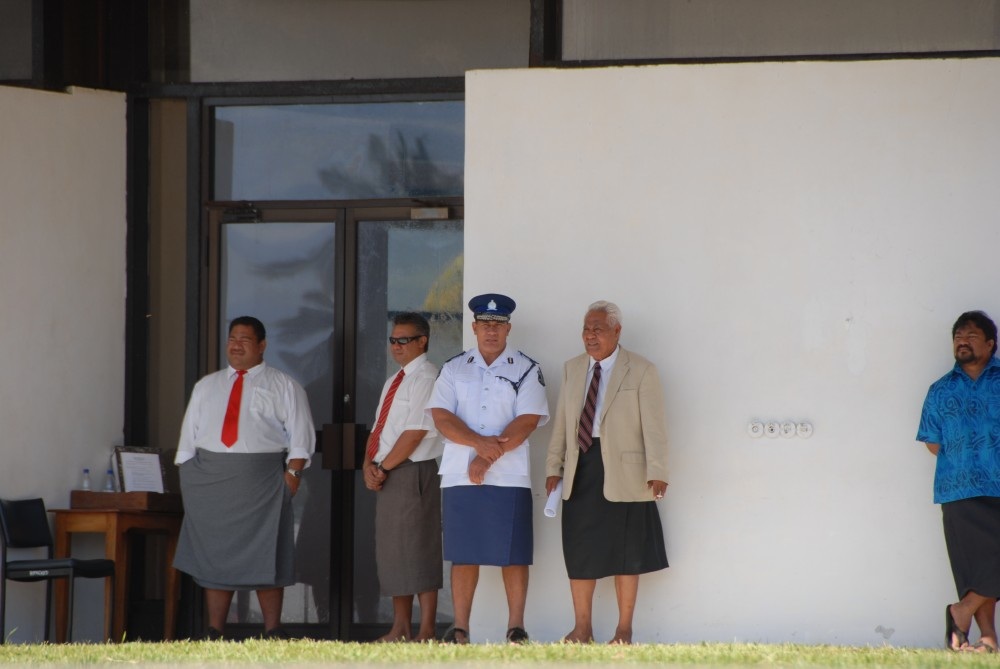Andre Vltchek
To fly from Samoa (formerly Western Samoa) to American Samoa — two utterly remote split-nation island territories in the South Pacific — used to be extremely easy and cheap. One only had to drive 5 kilometers from the capital – Apia – to the small village of Fagalii, to buy the ticket, chat for a while with fellow travelers sitting on plastic bags and outdated suitcases, go through some sort of improvised security and passport control, then board a little propeller-driven aircraft to Pago Pago, capital of American Samoa, a 20 minute hop, favorable winds provided.
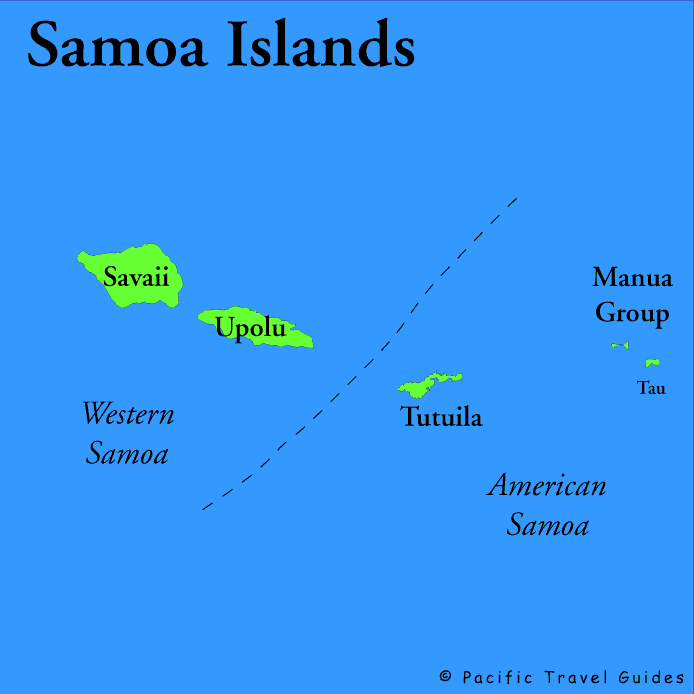
Nowadays, the tiny Twin Otter of Polynesian Airlines takes off from the international airport of Faleolo, opposite Upolu, a 40 minute drive from Apia. It is considered a regular international flight and to board it, one has to face the habitually obnoxious and incompetent staff of Polynesian Airlines, pay a departure tax, present a boarding pass to the guard, pass through passport control and then through an onerous security check (by contrast, in American Samoa, passengers to Samoa do not even have to pass a metal detector). Prices for this short hop have skyrocketed to US$140 round trip, a fortune for would-be local “commuters”.
The Twin Otter is all that is left of the Polynesian Airlines fleet that once flew Boeing 737-800s to Hawaii, Sydney, Auckland and elsewhere. They went bust leaving a single Dash-8 turboprop, connecting Apia with Tonga and servicing the tiniest country on earth (in terms of the population) – Niue. Mismanagement did not stop there and the Dash-8 was repossessed. Service to Tonga and Niue was suspended and now Polynesian Airlines have only one remaining destination – Pago Pago. The 737 had been repainted in new colors – Polynesian Blue – and transformed into a budget airline that often charges more than what it costs for a first class ticket for a similar distance in the US and elsewhere. The airline is partially owned by Australian budget carrier Virgin Blue; other shareholders are the Samoan government and the Aggie Gray hotel chain.
Immigration procedures are now so complicated because of the diplomatic saga that began in 2005, when Attorney General of American Samoa, Sialaga Malaetasi Togafau, proclaimed that he had tightened immigration rules because the 14-day permit allowing citizens of Samoa to enter U.S. territory of American Samoa had been abused. “Issuance of such permit,” he said, “would only be granted to those who qualify: business people and persons who need to travel urgently for medical reasons or to attend funeral.” The Attorney General also asked Samoan authorities to begin pre-scanning permit applicants.
What was not pronounced but widely understood to be a cause of Mr. Togafau’s decision, was that at the time when the ruling was made, approximately 600 Samoan illegal workers (out of about 1,000) were overstaying in American Samoa. Many of them were laboring in two large tuna canneries on the outskirts of Pago Pago.
Injured pride (Samoa is well know across the Pacific for its extreme nationalism and glorification of its culture) led to retaliation. Samoa declared that all visiting American Samoans would need to obtain travel permits and pay the entry fee, which fluctuates between US$10 and US$30, depending on the mood of government officials.
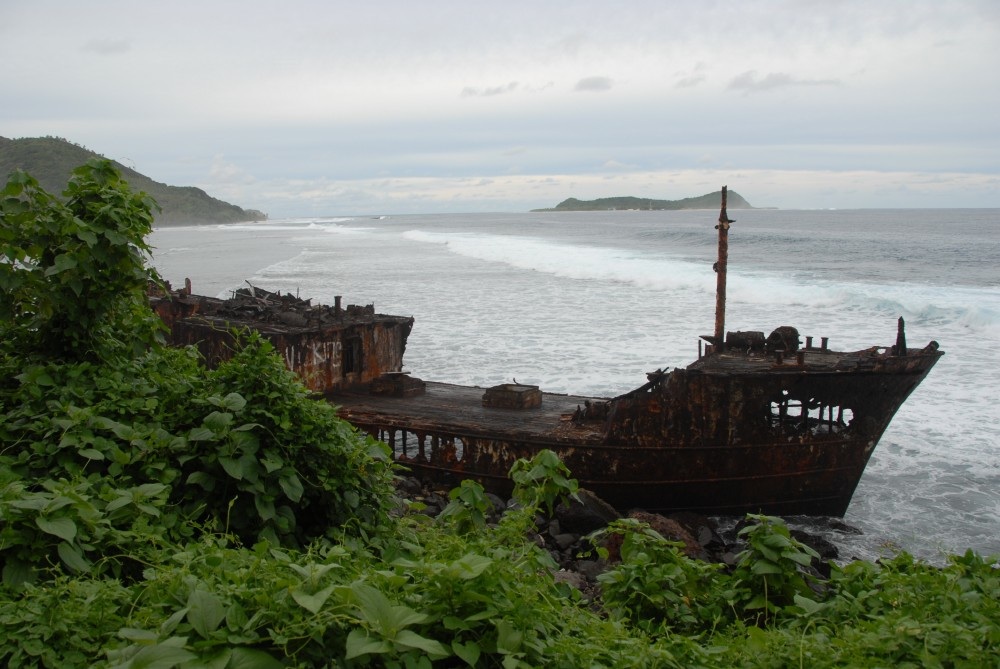 American Samoa, shipwrecked nation
American Samoa, shipwrecked nation
Regulations keep changing and are often ambiguous. The U.S. Department of State defines entry requirements of American Samoans to Samoa as follows: “U.S. nationals who are not U.S. citizens, and who are resident in American Samoa, must obtain a visitor permit prior to all travel to Samoa.” U.S. nationals have not been permitted to travel to Samoa on certificates of identity since May 2005 except on a case-by-case basis. U.S. law distinguishes between individuals who are citizens and those who are nationals. The U.S. passport bio-page indicates whether one is a citizen or a non-citizen national. From March 22, 2006, visitor permits to travel to Samoa can be applied for at the new Samoa Consulate General office in Pago Pago, American Samoa.
American Samoa’s Governor Togiola Tulafona has called Samoa’s entry permit a “revenue generating permit.” He notes that many Samoan citizens come to American Samoa to earn a living, while very few American Samoans go to Samoa with the intention of staying. The war of words and diplomatic gestures has been going on ever since.
Probably the most embarrassing chapter of the conflict was the case of MV Lady Naomi that arrived in Pago Pago, capital of American Samoa in October 2006, carrying the National University of Samoa rugby team. None of the players had the necessary entry permit. Attorney General Togafau of American Samoa fined the operator of the vessel, Samoan Shipping Corporation, US$20,000, and prevented the young people from disembarking.
The issue of the fine was subsequently settled, mainly on a technicality, since none of the rugby players actually stepped on American Samoa’s soil. But the incident indicates just how poisoned the atmosphere between two Samoas has become. Separated from each other across the ocean by just a few dozen kilometers, inhabitants of the two countries feel that their ties are increasingly severed. Fragmentation of the Pacific cannot serve the interests of its impoverished inhabitants.
Samoa, the region’s first independent country, having gained independence from New Zealand in 1962, has over 180,000 inhabitants. With US$ 2,593 GDP per capita it is still very poor, considering that it has some of the highest prices in the world. Among numerous paradoxes is the fact that it provides international organizations with inflated statistics while fighting a decision by the World Bank that it is ready to “graduate” from Least Developed Country status (LDC).
 Protest in front of Samoan parliament
Protest in front of Samoan parliament
Most of the long-term economic growth comes from remittances. Although slightly declining in 2007, remittances still represent approximately a quarter of the country’s GDP. According to Island Business magazine (Cherelle Jackson article, 2007), “Remittance receipts account for a growing percentage of the country’s GDP, according to the World Bank… 41.9 percent of Tonga; 26 percent of Samoa’s and 6.7 percent of Fiji’s GDP. ‘The cash that immigrants send home is a vital source of income for the daily survival of Pacific Islands households,’ said Dr Manjula Luthria, a senior economist with the World Bank’s Pacific office.”
Needless to say, American Samoa (a so-called “unincorporated” U.S. territory with 66,000 inhabitants) is one of the main magnets for economic migrants from Samoa, given the location of two of the world’s largest tuna processing factories that provide relatively higher wages in US dollars. Its GDP per capita is 9,041 (2005), approximately 3.5 times higher than in Samoa, although well below the U.S. poverty rate.
Immigration from Samoa is massive: according to New Zealand government statistics, in 2006, “131,103 people of Samoan ethnicity lived in New Zealand, about half of all those with Pacific ethnicity.” Further tens of thousands live in the United States, Australia and elsewhere. Samoa has what is called a ‘Samoa Quota Scheme’ with the Government of New Zealand where up to 1,100 people can legally migrate annually. Besides, Samoa is one of four countries benefiting from a recently launched seasonal workers scheme. Overall, there are more Samoans living abroad than in their own country.
There are many reasons, beside economic causes. Samoa is an extremely oppressive society, combining imported democratic principles and tribal rule of so-called “matais” (chiefs). Ordinary citizens are tightly controlled by the chiefs, the churches, including Mormons and Jehovah Witnesses, which are building enormous temples after extorting cash from the population, and the family.
Suicide rates are very high in both Samoas. Sexual abuse and rape of children are among the highest in the world. So is domestic violence and violent crime in general. While the local press reports grizzly cases of murder, it generally avoids publishing statistics.
A cover story from the Samoa Observer on May 8, 2008 is typical: “A father of nine is in police custody for allegedly kicking his wife’s face, killing her, last Friday morning, at Faleu Manono… He was trying to wake up his wife, Elisapeta Lei’atawa, 49, to fetch the milk for their grandchildren. But she said something to him so he kicked her on the jaw, . . .”
Earlier this year, Supreme Justice Patu Tiava’asu’e Falefatu Sapolu allowed a 19 year old “babysitter” to go free after he confessed that he was playing with the genitals of 3 years old girls. The judge ruled that the girl was not a virgin, anymore, as shown by expert witnesses, at the time when she was abused by the babysitter. There was no investigation as to who took the virginity of the child or when this occurred.
As Radio New Zealand International reported on November 01, 2007: “… The head of American Samoa’s criminal investigation bureau says up to 90 percent of child sex abuse cases in the territory go unreported.” RNZI quoted Commander Va’aomala Sunia as saying sexual abuse of minors is increasing every year, the vast majority of it happens within families.
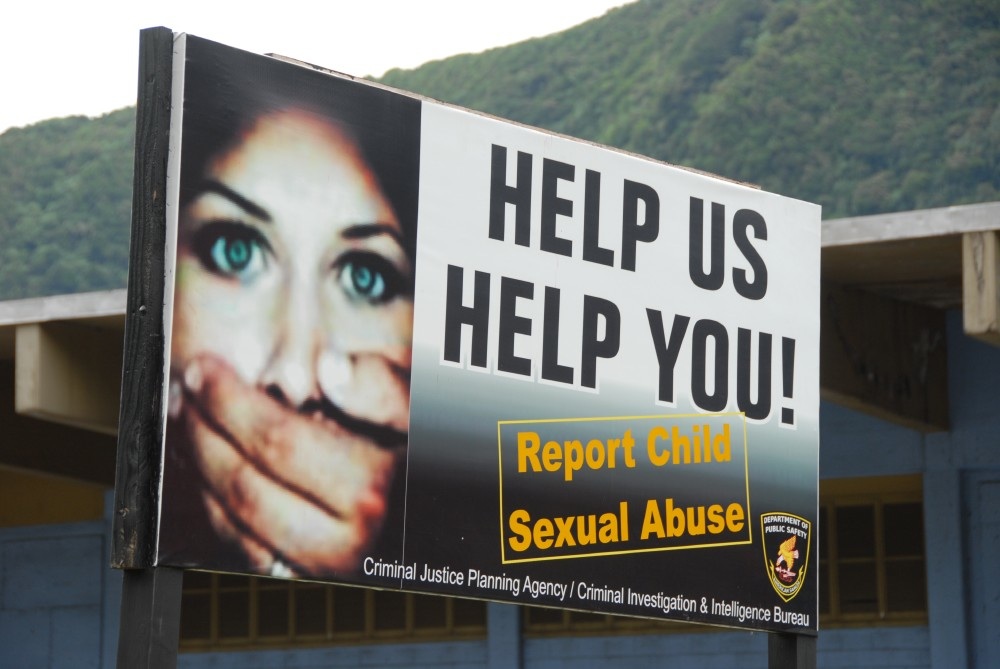 American Samoa child abuse prevention poster
American Samoa child abuse prevention poster
In Samoa the situation is much more serious, as there are no outside watchdogs that are allowed to bark. The rules of the game are these: “if you don’t like our way, then get out!” The international community in Apia is fully complacent, busy playing politically correct games of giving legitimacy to the feudal system. In a tremendously complex area populated by Pacific island nations, foreign donors and development agencies are desperately trying to create at least one star performer. Samoa had been designated as that star and, by avoiding scrutiny, the country gets away with almost everything. Any criticism invariably encounters a standard reply: “It is our culture and the Samoan Way”.
Boredom is another reason why many opt for emigration. There is not a single bookstore in the entire country of Samoa unless one counts a “bible shop” which calls itself “bookstore”, and there is but one cinema. Apart from religion and sports, locals have few other avenues for recreation. As a result, alcoholism and teenage pregnancies are serious problems. Samoa may be a paradise for a few mainly retired foreigners who call it home, but it is hardly a paradise for the great majority of Samoa’s people, despite the fact that they are constantly bombarded by nationalist and often xenophobic slogans. Fa’a Samoa – the Samoan Way – apparently justifies everything.
Going abroad is often the only escape for enterprising locals, but it often comes with an extremely high price tag. Families whose brightest sons and daughters go to foreign lands expect to be supported and showered with cash and gifts. It is a well known fact that those who refuse to send large sums of money first receive “warnings” from family and if they continue to ignore them, then next comes the curse designed to destroy health and life of the rebellious ones. Samoa is a very superstitious society and curses are taken seriously.
Naturally, there is a severe brain drain. Almost anybody who is confident and educated – leaves. A country whose main economic activities are remittances and foreign aid is simply unable to hold young and enterprising people. While tourism is becoming an important source of income (Samoa with its stunning natural beauty is now the third largest magnet for international tourism in the region, after Fiji and French Polynesia), its growth is not swift as the country is still known for its hostility towards foreign investors, as well as for the lack of transparency and complicated customary laws.
When the Twin Otter takes off from Faleolo International Airport in Samoa, the traveler is treated to one of the most beautiful views in the world: transparent turquoise water of the ocean, corals and the enormous island of Savaii with its volcanoes. Then, as the plane slowly turns, rusty tin roofs appear under the wing, together with the garbage and unmistakable signs of poverty and decay. Driving along the main roads, one sees neatly trimmed grass and bushes, as well as flowers. But from low altitude, it is possible to detect the reality of the back alleys.
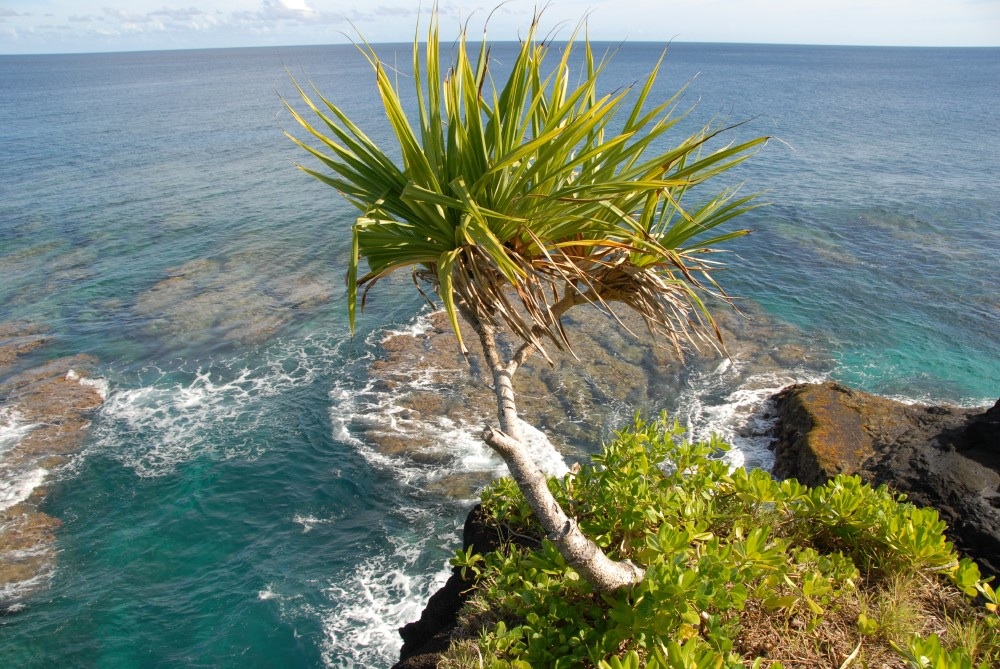 Spectacular Samoan natural beauty
Spectacular Samoan natural beauty
If there are no clouds, then it is possible to spot enormous gorges and waterfalls plunging from great heights to the lush greenery of the jungle – something one expects to see in Venezuela or Guyana, but not on the relatively small island of Upolu, in the middle of Pacific. There are no roads to some of the most beautiful areas of this stunningly beautiful country.
American Samoa is a 30 minute flight by slow propeller plane from West Samoa. The largest island where the plane lands – Tutuila – often described as a green dragon rising from the sea. As with Upolu in Samoa, it is one of the most beautiful places in the Pacific. But it has its own basketful of problems.
The first thing one spots after leaving the airport are enormous signs advertising 24 /7 McDonald’s, fully equipped with a brand new McCafe. Pizza Hut is across the street. That itself would not be strange by Pacific Island standards: McDonald’s is also one of the main ‘attractions’ in Apia, Samoa, owned by the Minister of Tourism. The clerk at the car rental agency helpfully confides that Pizza Hut and McCafe are the best places to eat in the country. True, the food in both Samoas is awful, but Big M as a gourmet’s choice?
Unlike Samoa, American Samoa sees hardly any tourists; a strange phenomena considering its amazing natural beauty. The only decent hotel, Clarion Tradewinds, is usually occupied by US military, advisers and local honeymoon couples. To make sure that nobody misses the point that this is – to some extent – the U.S., a huge stretch limousine is parked in front of the hotel entrance. In the several days that it took to compile this report, the limousine stood idle, blocking one of two available lanes in front of the hotel, as if to send some powerful message.
Food is hardly edible even in the restaurant adjacent to the hotel. Local eateries around the airport (that’s the location of choice, as Pago Pago is turning into a tiny “inner city” in the U.S. urban tradition) offer huge greasy cheeseburgers and mountains of fries. The only relatively healthy dish, a chef salad, is hidden somewhere at the back of the menu and costs much more than bacons and corn beef (favorites in both Samoas), as well as burgers and anything else that is loaded with cholesterol and calories. Cokes are served, Texas style, in something resembling sizeable fuel canisters.
If food is expensive in American Samoa, in Samoa it is simply outrageously overpriced. American Samoa is fully dependent on American imports, Samoa on frozen low quality food from New Zealand (mutton flaps and chicken feet being among the favorites). Spam (some with “halal” marks, rejected by one of the Arab countries and produced just about everywhere, including Brazil) is considered a delicacy in Apia.
In both Samoas, obesity is common and people, even by U.S. standards, are reaching tremendous proportions. In Apia, I was told that many men die when they are in their 40s. If they make it to 50, that’s a sign that they will reach old age. FAO experts, with whom I discussed the situation, were deeply concerned about the lack of education and awareness among Samoan population, regarding the food they are consuming. The most serious problem is diabetes, which has made inroads at alarming levels, although check-ups are random and hardly any reliable statistics exist. There are even amputees.
 American Samoa. Will the children be better off?
American Samoa. Will the children be better off?
Both Samoa and American Samoa hardly bother to grow anything or to fish. Instead, they are dependent on remittances and aid, although being a territory of the U.S. – American Samoa is technically not receiving “foreign aid”. A generally lacklustre agricultural sector leads to a situation in which people in Apia and Pago Pago have access to an extremely limited selection of local fruits and vegetables necessary for a healthy diet.
Five years ago I had the good fortune to be driven around American Samoa by Tofoitaufa Sandra King Young, who described herself as “the only public figure in American Samoa who seriously believes that the territory should be aiming at independence”. Mrs Young was Deputy Director for the Department of Interior’s Office of Insular Affairs during the Clinton Administration and she was a staff member of the Gore/Lieberman campaign in 2000.
She explained the very negative impact of the culture of dependency on American Samoa, but noted the difficulty of finding solutions to the problems. Apparently, the Kennedy Administration had been shamed by the U.S. press for “abandoning the territory”, for investing very little in its social system and infrastructure. A huge influx of funds apparently followed, but years later, the target of criticism had shifted to the excessive influence that accompanied funds from the mainland.
In the 21st century, American Samoa is a very sad place. With few employment opportunities, there are hundreds of illegal workers. Local youth aimlessly hang around the capital city, which increasingly resembles U.S. ghettos: abandoned and burned down buildings, general disrepair, population outflow to the suburbs, lack of services, and graffiti ‘decorating’ the walls of the houses. The only hotel in town had to close one of its wings because of a lack of guests.
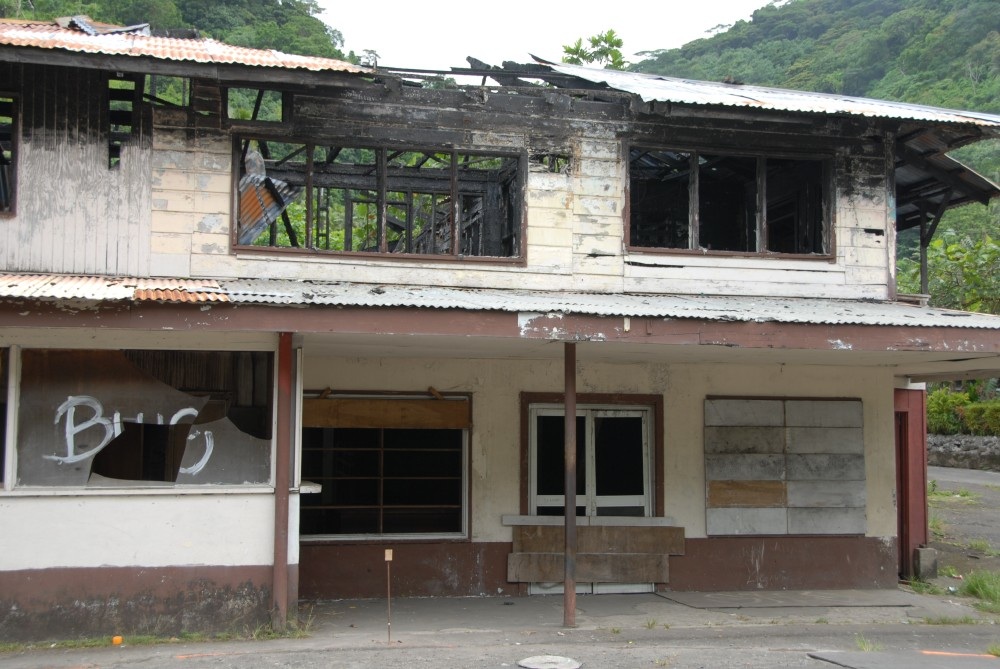 Burnt out building in downtown Pago Pago
Burnt out building in downtown Pago Pago
Behind barbed wire, the “United States Reserve Te’o Soldiers Support Center” offers a suicide hotline number posted near the entrance, together with other emergency telephone numbers. American Samoans are dying in disproportionate numbers, in Iraq and Afghanistan. It is difficult to compile exact figures but, by the time this report was written, at least 15 American Samoans had died in Iraq. The death toll is tremendous, considering the population of the territory (only 66.000 people). And tens of American Samoan soldiers come back mutilated, while the devastating combat experience forever marks hundreds.
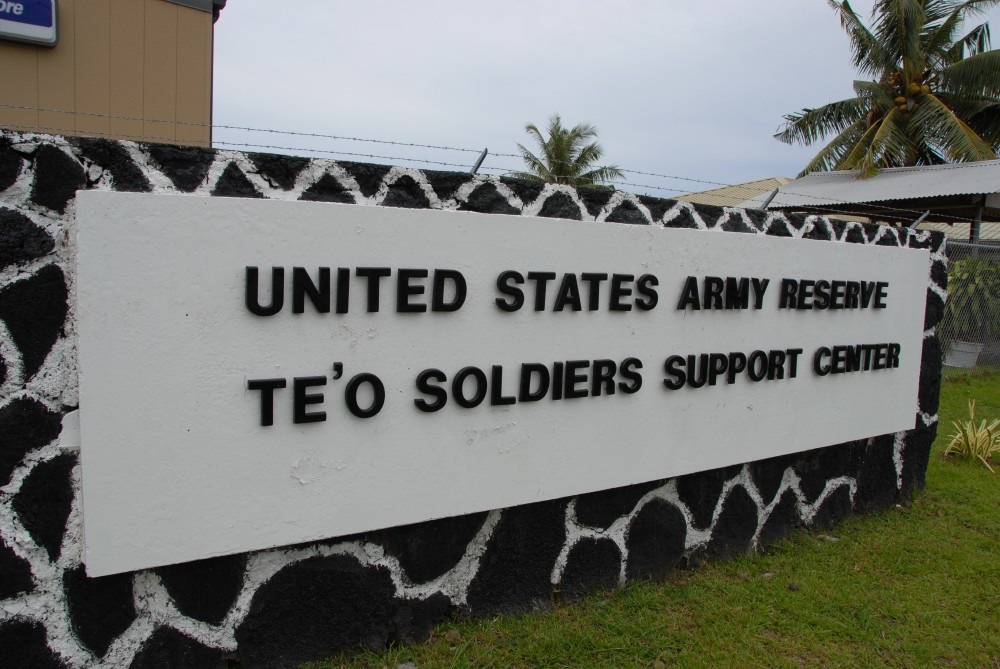
On March 5th, 2006, when the death toll was still much lower, NBC News acknowledged that American Samoa is a recruiter’s dream. They come around, explaining benefits for the young people to sign on, including such attractive perks as100 percent paid college tuitions. But the NBC reporter summarized:
“Hidden by the staggering beauty of this island is a per capita income that is below the U.S. poverty level. Most wages are low, and there are relatively few employment options for young people. The only big employers are tuna canneries and the government. For many residents, the military is the best — and perhaps, the only — way out…
But American Samoa has paid a heavy price… It has the highest per capita death rate of any U.S. state or territory.Among the victims was 22-year-old Tina Time, who was killed in a desert convoy accident. In the Samoan tradition, her crypt lies in front of the parents’ house, bedecked with flowers.
Inside the house, her mother, Mary Time, has erected a memorial shrine, featuring many of Tina’s glamour photographs, medals, sympathy cards, and condolence letters from President George W. Bush and Secretary of Defense Donald Rumsfeld.
With three other children in the U.S. military, Mary Time still supports American involvement in Iraq — despite her daughter’s death.
“She didn’t die in vain. We need to complete what we started, and I’m with the president that this war is for a good cause,” Time says. Looking at her daughter’s photographs, and wiping her eyes, she adds, “I miss her, she was a good girl.”
In fact the death of Tina Time became a symbol of senseless loss of the lives of so many young Pacific Islanders. One of her obits circulating on U.S blogs talks about her being a bright student and a member of the choir. But it also feels obliged to explain to American readers what American Samoa is and where it is located.
In American Samoa, yellow ribbons are everywhere, as well as stickers on car bumpers saying “Support Our Troops in Iraq”. On one of the most picturesque parts of the island, an enormous banner reads: “May Peace Be With Our Samoan Soldiers in Iraq. God Bless You All.” U.S. flags are everywhere. Surprisingly, they are also attached to cars in independent Samoa, which, in accordance with the New World Order Gospel, is staunchly pro-U.S., anti-Communist, anti-Chinese and stalwartly religious. On the streets of Pago Pago, even at the beach, children are playing with plastic toy machine guns.
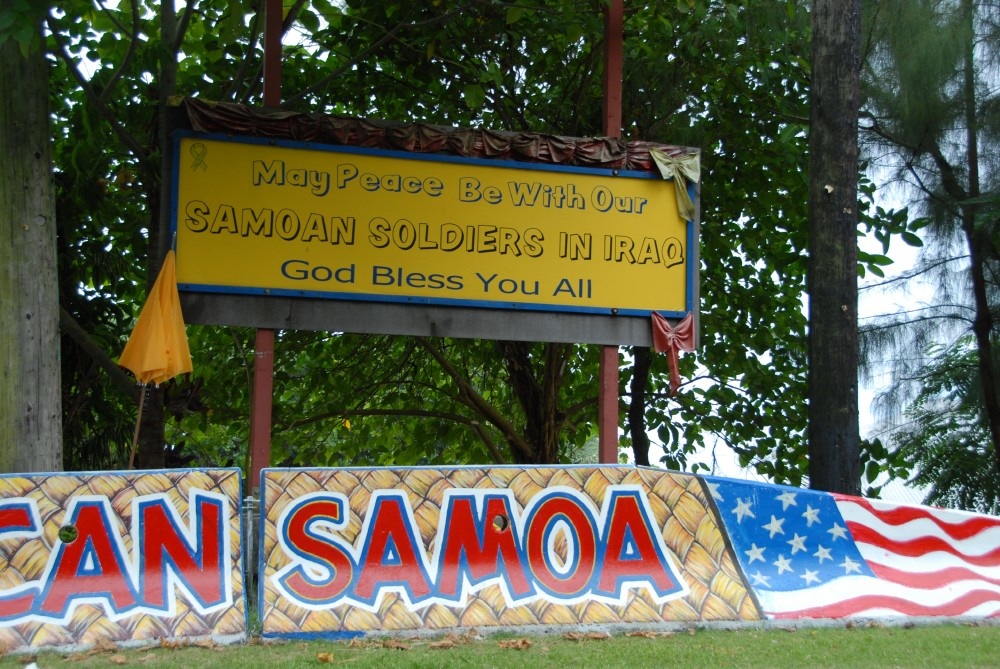
One of the most shocking images of American Samoa I encountered was that of a man wearing a T-shirt saying “NAVY – Celebrate Life”, sitting at the back of the boat plying between Aunu’u Island and Tutuila and turning a toy gun in his hands. Profound depression and confusion engraved his face.
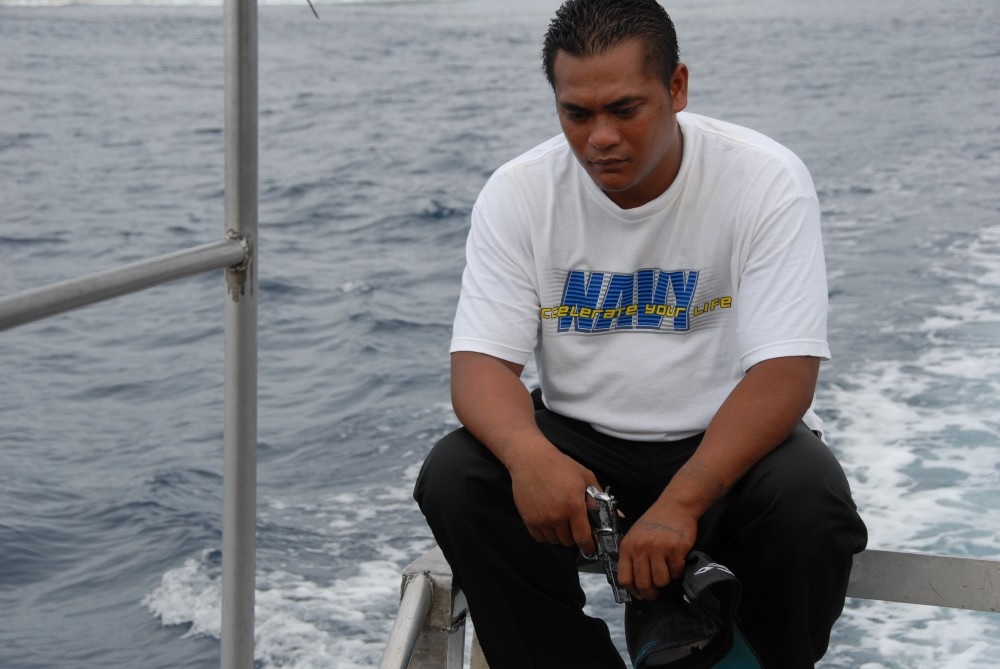
As an old lady on remote Aunu’u Island explained: “Many people want to serve in the US Navy or army. They want to make money but they also want to join the army to escape boredom – to experience adventure that they are being promised. Many people here are very poor, working for 3 dollars an hour. We have over 400 inhabitants on the island, but every week someone leaves for the U.S. To some it doesn’t matter what they are going to do on the mainland: whether they wash dishes or go to the military barracks.”
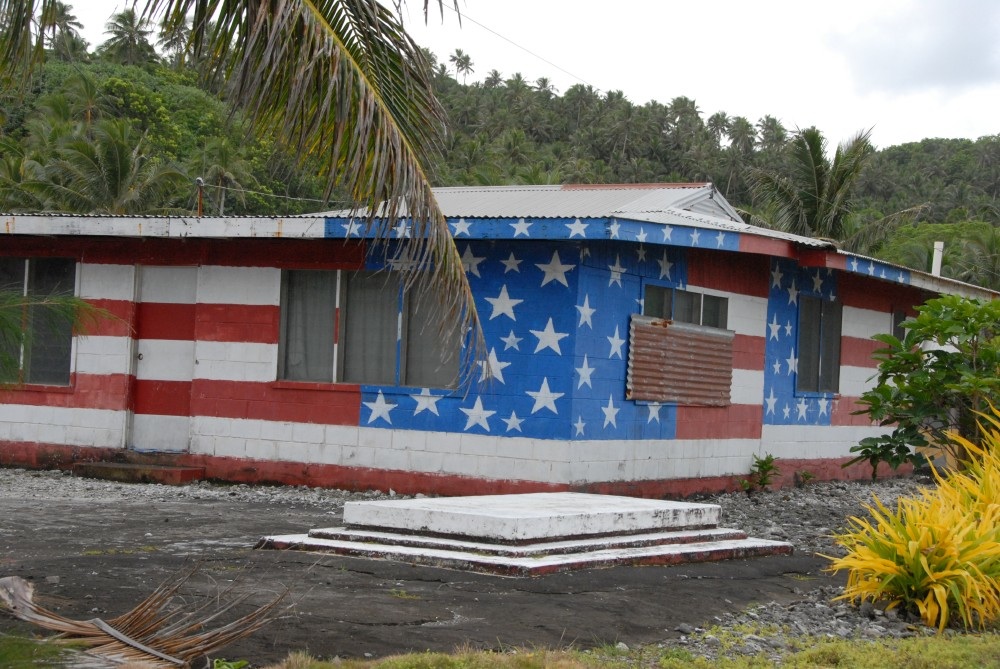 American Samoa: Celebrating the American way
American Samoa: Celebrating the American way
Leaving American Samoa, there is, surprisingly, no security check (a security machine is used only for flights to Hawaii, not to Samoa). The airport building is old and shabby. This is the same airport where a Hawaiian Airlines Boeing 767 broke its wheel when landing on a runway full of debris a few years ago.
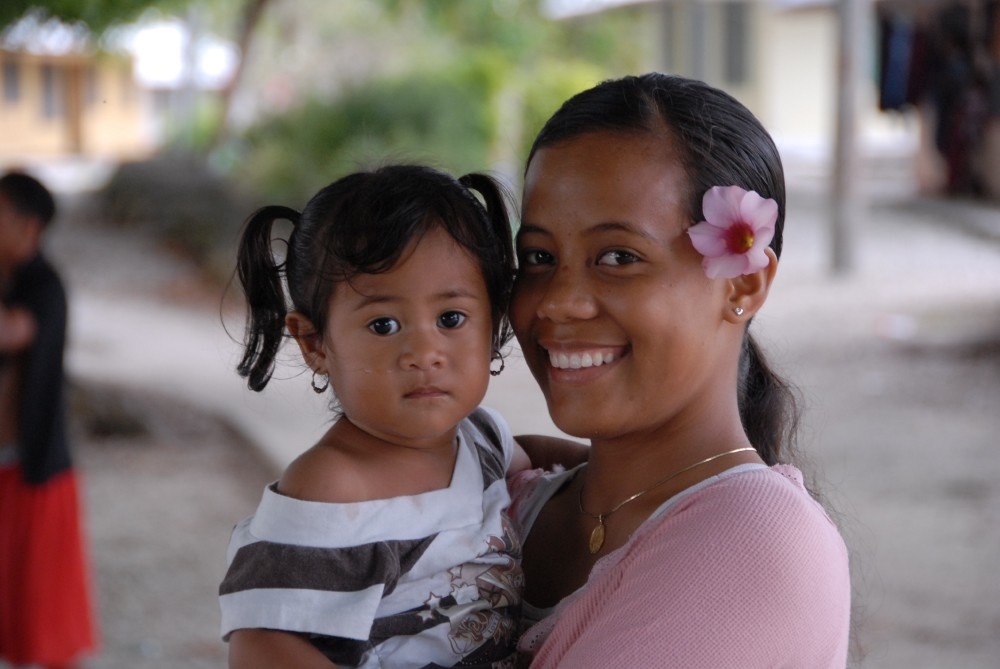
Despite everything, much beauty remains
Another magnificent flight provided tremendous vistas. But at both ends of the horizon were two countries dividing one nation, one people. One country ruled by an ancient and oppressive feudal culture, another a “protectorate” of empire, but still shockingly poor. By comparison, French colonies in the region are wealthy relative to American Samoa. And the gap between the two Samoas is growing. Alas, there is no movement on either side that would promote unification. In a few years, the two Samoas (and their peoples) may become too different to call themselves a single nation.
Andre Vltchek is a novelist, journalist, filmmaker, playwright, editorial director of Asiana Press Agency, cofounder of Mainstay Press, and a senior Fellow at The Oakland Institute. He is presently living and working in Asia and South Pacific. He wrote this article in Apia and Pago-Pago. He can be reached at: [email protected].
A Japan Focus associate, he wrote this article and provided the photographs for Japan Focus. Posted on June 24, 2008.



